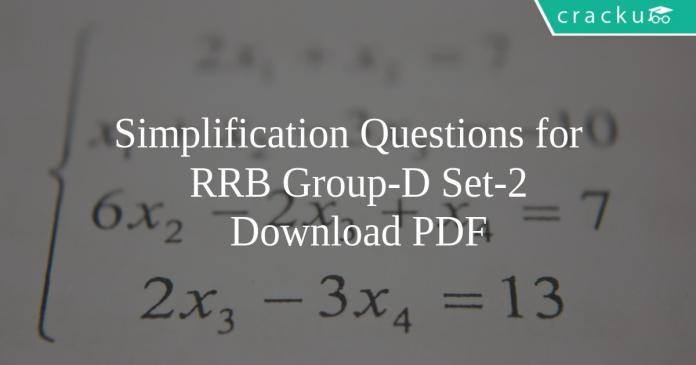Simplification Questions for RRB Group-D Set-2 PDF
Download Top 15 RRB Group-D Simplification Set-2 Questions and Answers PDF. RRB Group-D Maths questions based on asked questions in previous exam papers very important for the Railway Group-D exam.
Download Simplification Questions for RRB Group-D Set-2 PDF
Download RRB Group-D Previous Papers PDF
Take a RRB Group-D free mock test
Question 1: What is the area between the lines 5x+4y=20 and x+y=15 in the first quadrant?
a) 117.50 sq units
b) 110 sq units
c) 105 sq units
d) 102.50 sq units
Question 2: If x and y are positive real numbers such that 15x + 12xy +20y = 96, find the minimum possible value of 6x + 8y ?
Question 3: How man Y different pairs(a,b) of positive integers are there such that $a\geq b$ and $\frac{1}{a}+\frac{1}{b}=\frac{1}{9}$?
Take a free mock test for RRB Group-D
770 Mocks (cracku Pass) Just Rs.199
Question 4: Find $x +y$ if $\frac{90}{3x – y} + \frac{46}{2x + 3y} = 7$ and $\frac{92}{2x + 3y} – \frac{36}{3x – y} = 2$.
Question 5: Solve the given system of equations in three variables:
x + 3y -z = 5
3x + y + 4z = 22
2x +6y -2z = 56
a) x = 35/34, y = 91/34, z = 69/17
b) x = -123/25, y = 147/25, z = 193/25
c) infinite solutions
d) no solution
Question 6: Roots of the quadratic equation $px^2 + p^2(x + 1) – 4p = 0$ are reciprocal to each other. How many values of $p$ are possible?
RRB Group D previous year papers
Question 7: If $(x-5)^{\frac{x^2 – 24x + 95}{x^2 – 13x + 36}} = 1$
What is the sum of all real values of ‘x’ which satisfy the given equation?
a) 21
b) 25
c) 29
d) 30
Question 8: If $x^{2}$+3x-10is a factor of $3x^{4}+2x^{3}-ax^{2}+bx-a+b-4$ then the closest approximate values of a and b are
a) 25, 43
b) 52, 43
c) 52, 67
d) None of the above
Question 9: Find the number of integral solutions of $\sqrt{x + 15 – 8\sqrt{x – 1}} + \sqrt{x + 24 – 10\sqrt{x – 1}} = 1$
Question 10: If $x^4 – 79x^2 + 1 = 0$, find the value of $x^3 + \frac{1}{x^3}$ if x>0.
a) 702
b) 970
c) 720
d) None of these
RRB Group-D Important Questions (download PDF)
Question 11: If the roots of $x^3 +3 x^2 + px – q = 0$ are in A.P, then which of the following is possible?
a) p = 5, q = -5
b) p = 4, q = 0
c) p = 1, q = -2
d) p = 2, q = 0
e) p = 0, q = -3
Question 12: If x =$\sqrt{2}-1$, find the value of $x^4+4x^3+6x^2+4x+8$.
a) 9
b) 10
c) 11
d) 12
Question 13: Solve the equation: $(7-x)^{4} + (9-x)^{4} = 16$
a) 9
b) 7
c) Both the above
d) None of the above
Question 14: Solve the equation: (x+2)(x+4)(x+6)(x+12)=-4$x^2$, $x^2$ = ?
a) $-10 \pm 2\sqrt {3}$
b) $-11 \pm 2\sqrt {3}$
c) $-12 \pm 2\sqrt {3}$
d) $-13 \pm 2\sqrt {3}$
Question 15: The maximum value of y = $ – x^2 + 6x- 8 $ is
a) 0
b) 1
c) 2
d) 3
General Science Notes for RRB Exams (PDF)
Answers & Solutions:
1) Answer (D)
Multiplying the second equation by 5 and subtracting from the first equation,
$5x+4y=20 $
$5x+5y=75$
Solving, $4y-5y = 20 – 75 \Rightarrow y=55$
Putting the value of $y$, $x = 15 – 55 = -40$
Since this point is outside the first quadrant, we need to find the intercepts of the lines on the $x$ and $y$ axis to get an idea of the shape of the area.
For line 1 : $5x+4y=20$
Putting x=0, $y=\dfrac{20}{4}=5$
Putting y=0, $x=\dfrac{20}{5}=4$
Intercepts : (0,5) and (4,0)
For line 2 : $x+y=15$
Putting x=0, $y=15$ and putting y=0, $x=15$
Intercepts : (15,0) and (0,15)
Upon rough drawing, we get a graph something like this :

Point O is the origin while A,B and C,D are intercepts of line 2 and line 1 respectively.
The area of the between the two lines can be calculated by subtracting the area of $\triangle$DOC from the area of $\triangle$AOB
Thus, area of $\triangle$AOB $a_1 = \dfrac{1}{2} \times 15 \times 15$
$ \Rightarrow a_1 = \dfrac{225}{2} $ sq. units
Now, area of $\triangle$DOC $a_2 = \dfrac{1}{2} \times 5 \times 4$
$ \Rightarrow a_2 = 10$ sq units
Therefore, area between the lines = $\dfrac{225}{2} – 10 = \dfrac{205}{2} = 102.50$ sq. units
2) Answer: 24
Given that: 15x + 12xy +20y = 96
$\Rightarrow$ 15x + 12xy +20y +25 = 96 +25
$\Rightarrow$ 5(3x + 5) + 4y(3x + 5) = 121
$\Rightarrow$ (3x + 5)(4y + 5) = 121
If thee product of two positive numbers (3x + 5) and (4y + 5) is constant, then the minimum value of sum occurs when the number are equal i.e. 3x + 5 = 4y + 5 = 11
$\therefore$ The minimum value of (3x + 5) + (4y + 5) = 11 + 11
Hence, the minimum value of 3x + 4y = 22 – 10 = 12, hence minimum value of 6x + 8y = 2*12 = 24 (Answer)
3) Answer: 3
$\frac{1}{a}+\frac{1}{b}=\frac{1}{9}$
=> $ab = 9(a + b)$
=> $ab – 9(a+b) = 0$
=> $ ab – 9(a+b) + 81 = 81$
=> $(a – 9)(b – 9) = 81, a > b$
Hence we have the following cases,
$ a – 9 = 81, b – 9 = 1$ => $(a,b) = (90,10)$
$ a – 9 = 27, b – 9 = 3$ => $(a,b) = (36,12)$
$ a – 9 = 9, b – 9 = 9$ => $(a,b) = (18,18)$
Hence there are three possible positive integral values of (a,b)
4) Answer: 10
Let
$\frac{1}{3x – y} = a$ and $\frac{1}{2x + 3y} = b$
Therefore,
$92b – 36a = 2$ and
$46b + 90a = 7$
Multiplying ii by 2 and subtracting i from it,
$216a = 12$
$a = \frac{1}{18}$
Substituting in ii,
$b = \frac{1}{23}$
Therefore,
$3x – y = 18$ and $2x + 3y = 23$
Multiplying the first equation by 3 and adding both the equations.
$11x = 77$, $ x = 7$
Hence, $y = 3$
$x + y = 10$
5) Answer (D)
The coefficient matrix of the given system of equations = M =
$\begin{bmatrix}
1 &3 &-1 \\
3&1 &4 \\
2&6 &-2
\end{bmatrix}$
|M| = D = 1(1x-2-6×4)-3(3x-2-6x-1)+2(3×4-1x-1) = 0
The x numerator matrix of the given system of equations = M$_x$ =
$\begin{bmatrix}
5 & 3 &-1 \\
22&1 &4 \\
56&6 &-2 \end{bmatrix}$
|M$_x$| = D$_x$ = 5(1x-2-6×4)-22(3x-2-6x-1)+56(3×4-1x-1) = 598
Since, at-least one of the numerator matrix is non-zero, the given set of equations have no solution
6) Answer: 1
Since the roots are reciprocal to each other , product of roots must be equal to 1.
Writing the given equation as $px^2 + p^2x + p^2-4p$ = 0
So, $\frac{p^2 – 4p}{p}$ = 1
or, $p^2 – 5p$ = 0
Solving this equation, we get roots as $p$ = 0 and $p$ = 5
But, $p$ cannot be 0 because then the given equation would not be quadratic. Hence, only one value of $p$ is possible
7) Answer (B)
We have $(x-5)^{\frac{x^2 – 24x + 95}{x^2 – 13x + 36}} = 1$
$ x^2 – 24x + 95 = (x-5)(x-19) $
$ x^2 – 13x + 36 = (x-4)(x-9) $
So, $(x-5)^{ \frac{(x-5)(x-19)}{(x-4)(x-9)} } = 1$
Case 1 –
Consider following possibility,
x – 5 = 1 i.e. x = 6
So $\frac{(x-5)(x-19)}{(x-4)(x-9)} = \frac{1*-13}{2*-3}$
So x=6 satisfies
Case 2 –
Consider, x-5 = -1
x = 4
So $\frac{(x-5)(x-19)}{(x-4)(x-9)} = \frac{-1*-15}{0*-3} $
So, x=4 does not satisfy
Case 3 –
Consider $\frac{(x-5)(x-19)}{(x-4)(x-9)} = 0 $
$ (x-5)(x-19) = 0$
x = 5 or x = 19
For x = 5, the base becomes 0. So not possible.
For x = 19, the equation will be satisfied.
Thus, 2 values of x, i.e. 6 and 19 satisfy the given equation.
Sum = 6 + 19 = 25
Hence, option B is the right answer.
8) Answer (C)
If $x^{2}$+3x-10is a factor of $3x^{4}+2x^{3}-ax^{2}+bx-a+b-4$
Then x = -5 and x = 2 will give $3x^{4}+2x^{3}-ax^{2}+bx-a+b-4$ = 0
Substituting x = -5 we get,
$3(-5)^{4}+2(-5)^{3}-a(-5)^{2}+b(-5)-a+b-4 = 0$
Solving we get,
$26a+4b = 1621$…….(i)
Substituting x = 2 we get,
$3(2)^{4}+2(2)^{3}-a(2)^{2}+b(2)-a+b-4 =0$
=> $5a-3b = 60$……..(ii)
Solving i and ii we get
a and b $\approx 52, 67$
Hence, option C is the correct answer.
9) Answer: 10
Let $\sqrt{x – 1} = t$
$x = t^2 + 1$
Substituting the value of t in the given equation,
$\sqrt{t^2 – 8t + 16} + \sqrt{t^2 – 10t + 25} = 1$
$\sqrt{(t – 4)^2} + \sqrt{(t – 5)^2} = 1$
|t – 4| +|t – 5| = 1
The following equation is true for $4 \leq t \leq 5$
The corresponding values of x are $ 17 \leq x \leq 26$
Hence, 10 integral values exist.
10) Answer (A)
$x^4 – 79x^2 + 1 = 0$
Dividing both sides by $x^2$
=> $x^2 -79 + \frac{1}{x^2} = 0$
=> $x^2 + \frac{1}{x^2} = 79$
Adding 2 on both sides.
$x^2 + \frac{1}{x^2} + 2 \frac{1}{x^2}x^2 = 81$
=> $(x+\frac{1}{x}) = \pm 9$
But since x>0, $(x+\frac{1}{x}) = 9$
Now, $x^3 + \frac{1}{x^3} = (x+\frac{1}{x})(x^2 + \frac{1}{x^2} – 1)$
=> $x^3 + \frac{1}{x^3} = 9 (79 – 1) = 702$
11) Answer (D)
Let the roots of the given equation be a -d, a and a + d
Sum of roots of the equation = a – d + a + a + d = 3a = -3
=> a = -1
Sum of product of roots taken two at a time = (a – d)a + a( a + d) + (a – d)(a – d) = $3a^2 – d^2$ = p
$3 – p = d^2$
=> 3 – p $\geq$ 0, Thus, p $\leq$ 3
Product of roots of the equation = $(a – d)a(a + d) = a(a^2 – d^2) = q$
$1 – d^2 = -q$
=> q $\geq$ -1
From the options only option D satisfies the given conditions.
12) Answer (C)
x =$\sqrt{2}-1$
x+1 =$\sqrt{2}$
$(x+1)^4 = 4$
$x^4+4x^3+6x^2+4x+1$ = 4
$x^4+4x^3+6x^2+4x+8$ = 4+7 = 11
13) Answer (C)
Let z = (7-x + 9 – x )/2 = 8-x
So, the equation becomes $ (z-1)^4 + (z+1)^4 = 16$
$z^4+6z^2-7=0$
= > $ (z^2+7)(z^2-1)=0$
Taking only real values, z = -1 or 1
X = 9 or 7
14) Answer (C)
Since (-2)(-12) = (-4)(-6), we can re-arrange the equation as (x+2)(x+12)(x+4)(x+6)
= > ($x^2+14x+24)(x^2+10x+24$)
Since x= 0 is not a root, dividing by $x^2$ on both sides,
We get (x + 14 + 24/x)(x+10+24/x) = -4
Putting x + 24/x = y, we get
(y + 14)(y + 10) = -4
$ y^2 + 24y+144=0$
Y = -12
X+24/x = -12
$x^2 +12x+24=0$
x = $\frac{ -12 \pm \sqrt {144-96}}{2}$
=$ -12 \pm \sqrt {12}$
=$-12 \pm 2\sqrt {3}$
15) Answer (B)
$ – x^2 + 6x- 8 $ can be rewritten as – ($ x^2 – 6x + 8 $)
= – (x-2)(x-4)
The roots of the equation are 2,4. The midpoint of the roots is x = 3. That is where the maximum of the function occurs. Substituting x = 3 in the function, we get the maximum point as -9 + 18 – 8 = 1
DOWNLOAD APP FOR RRB FREE MOCKS
We hope this Simplification Set-2 Questions for RRB Group-D Exam will be highly useful for your preparation.





